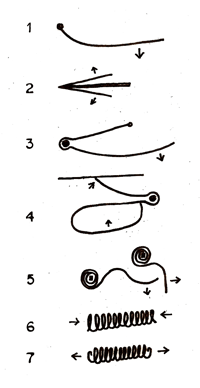This section is about the role of springs in the development of locks. It is no exaggeration that iron or steel springs are vital features of the lock’s technological development.
The word spring comes from the Old English and Old High German springan, or springa in Old Frisian, meaning “to leap, burst forth, fly up”.
In German and the Scandinavian languages, the word for “spring” (German Feder, Swedish fjäder, Danish fjeder or fjer, Norwegian fjær or fjør, Icelandic fjǫðr) comes from the word “feather” – a notably springy object in the natural world.
Why springs
This section is about the role of springs in the development of locks. It is no exaggeration that iron or steel springs are vital features of the lock’s technological development. Parts of the mechanisms just don’t work without springs. Yet technical literature tends to give springs a very humble role. Many authors will mention that there is a spring in the lock, but rarely do they point out its crucial importance. “It is installed here, and does this or that.”
We encounter springs in all sorts of contexts, sometimes completely unexpected. Those who work with mechanical products often feel that springs seem to have lives of their own. It can be difficult to manage these unruly coils of metal that seem to be full of life and energy. They have a peculiar ability to suddenly and unexpectedly abandon their hidden place in a construction, with no clue as to where they came from.
And yet of course we users give them life and meaning, charging them with energy by pressing them together or pulling them apart. They are there, hidden, invisible, and we can’t get along without them.
Starting in the 18th century, springs made traveling with horse-drawn carriages much more comfortable. Clocks, timepieces, were fitted with windable springs. In the latter half of the 19th century, springs helped to make train travel a pleasure, starting with the Pullman cars in the United States. The very first cars ever made were fitted with springs, and spring mattresses have long contributed to a good night’s sleep. Without springs, we would not be able to lock the door behind us. And so much more.
Springs in lock constructions
As mentioned before, springs are a necessity for the function of locks. See the chapter entitled Lock and key lexicon for a short introduction.
Springs.
Lock springs have played an important role in the design and function of locks throughout history. In the Roman locks, ward springs were used in padlocks and as compression springs in pin tumbler locks. In Scandinavia, ward spring padlocks have been in use from the Viking Era until well into the 18th century. Various types of springs were also used in door locks and chest locks. Prior to 1600 they were V-shaped, while later they could also be rolled, helical springs. Early springs were manufactured of cold-hammered iron, making them quite heavy. Chest locks generally have ring-shaped springs.
Most metal locks have some type of steel springs. A lock spring creates tension – which is usually what the key must displace in order to turn the bolt. Thus, springs store power to perform a task either now or later: pushing forward, holding back or softening a force. Springs have done this kind of work for nearly 2,000 years.
Examples of lock springs

1. Simple plate spring. About 200 AD until the 17th century.
2. Ward springs. About 100 BC until the 19th century.
3. V-shaped plate springs. About 15th to 17th century.
4. Tumbler with plate spring. About 15th century.
5. Torque springs. About 17th century.
6. Compression springs. About 18th century.
7. Tension springs. About 19th century.